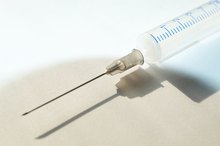What does fact checked mean?
At Healthfully, we strive to deliver objective content that is accurate and up-to-date. Our team periodically reviews articles in order to ensure content quality. The sources cited below consist of evidence from peer-reviewed journals, prominent medical organizations, academic associations, and government data.
The information contained on this site is for informational purposes only, and should not be used as a substitute for the advice of a professional health care provider. Please check with the appropriate physician regarding health questions and concerns. Although we strive to deliver accurate and up-to-date information, no guarantee to that effect is made.
Medications to Help Dry Up Milk Supply
While many breast-feeding women are trying to boost their milk supply, others may be looking for ways to slow it down. Whether you are trying to stop breast-feeding or simply to prevent engorgement, there are a few simple ways to reduce your milk supply both with and without the use of medications.
Reasons
Some women choose not to breast-feed their babies from birth, or they may decide after a short time that breast-feeding is not right for them. When you stop breast-feeding cold turkey, you may experience engorgement, a condition when the breasts fill with milk faster than it can be released. Engorgement can be uncomfortable and sometimes painful, causing many women to turn to alternative methods of drying up their milk supply. For some, this may include prescription medications 1.
- Some women choose not to breast-feed their babies from birth, or they may decide after a short time that breast-feeding is not right for them.
- Engorgement can be uncomfortable and sometimes painful, causing many women to turn to alternative methods of drying up their milk supply.
Medications Used
Decreased Milk Supply & Mirena
Learn More
Both estrogen, bromocriptine and bromocriptine-related drugs have been used historically to decrease milk supply in women who are lactating. In the past, estrogen was administered by injection for this purpose. In addition, bromocriptine and related drugs were either taken over a short time or administered in a single-dose strength. Both approached are effective. However, there has been some question as to whether these medications are safe for lactating moms.
- Both estrogen, bromocriptine and bromocriptine-related drugs have been used historically to decrease milk supply in women who are lactating.
- In the past, estrogen was administered by injection for this purpose.
Risks
Both estrogen and bromocriptine had been used regularly in the past to dry up a woman’s breast milk supply. However, based on research citing potential health risks, their use for this purpose is far less common today. Estrogen injections increase a woman’s risk of developing a blood clot, which can lead to a stroke or even death. Bromocriptine has similar risks: It increases a woman’s chance of heart attack or stroke, and it is especially risky if the woman in question has a history of high blood pressure. While estrogen and the original form of bromocriptine are no longer recommended for use with lactating women, bromocriptine-related drugs are a safer option. However, their use is generally combined with blood-thinning medications to decrease the risk of blood clot formation.
- Both estrogen and bromocriptine had been used regularly in the past to dry up a woman’s breast milk supply.
- However, their use is generally combined with blood-thinning medications to decrease the risk of blood clot formation.
The Alternatives
Progesterone Cream & Breastfeeding
Learn More
For many women, the risks of using medications to dry up their milk supply far outweigh the benefits. Fortunately, there are other ways to reduce discomfort when weaning from breast-feeding that do not require prescription drugs. You can simply let your milk supply wane naturally. However, in the meantime, you can use a heating pad, ice packs and/or over-the-counter pain medications to relieve any related breast discomfort). Other ways to reduce milk supply include reducing fluid intake, which is necessary for breast milk production, and using breast compression techniques. Over time, without a steady demand, breast milk supply will decrease on its own.
- For many women, the risks of using medications to dry up their milk supply far outweigh the benefits.
- Fortunately, there are other ways to reduce discomfort when weaning from breast-feeding that do not require prescription drugs.
Related Articles
References
- Mayo Clinic: Lactation Suppression: Can Medications Help?
- The WHO Reproductive Library: Treatment for Suppression of Lactation
- Memorial Sloan Kettering Cancer Center. Can I Breast-feed during Cancer Treatment? Published August 2, 2016.
- American Cancer Society. Pregnancy After Breast Cancer. Updated October 3, 2019
- Kotsopoulos J, Lubinski J, Salmena L, et al. Breastfeeding and the risk of breast cancer in BRCA1 and BRCA2 mutation carriers. Breast Cancer Res. 2012;14(2):R42. Published 2012 Mar 9. doi:10.1186/bcr3138
Writer Bio
Erica Jacques is an occupational therapist and freelance writer with more than 15 years of combined experience. Jacques has been published on Mybackpaininfo.com and various other websites, and in "Hope Digest." She earned an occupational therapy degree from Queen Margaret University in Edinburgh, Scotland, giving her a truly global view of health and wellness.









